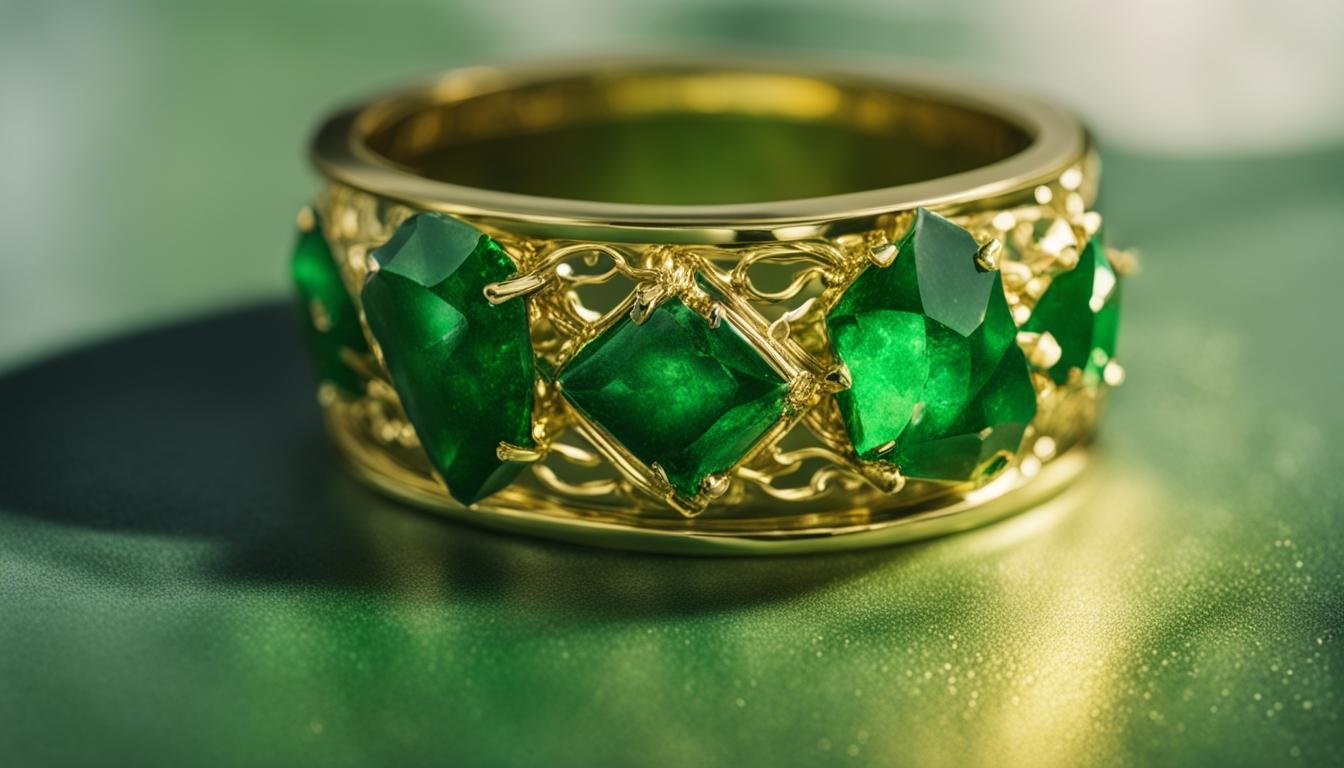Does Gold Plated Jewelry Turn Green?
Gold plated jewelry is a popular choice for its affordability and attractive appearance. However, over time, gold-plated jewelry can tarnish and turn green. Taking proper care of your gold-plated jewelry can help prevent this issue.
Gold plated jewelry provides a budget-friendly option for those who desire the luxurious look of gold without breaking the bank. But why does it sometimes lose its shine and develop a greenish hue?
In this article, we will explore the factors that cause gold plated jewelry to tarnish, how gold plating works, and essential tips to prevent your precious accessories from turning green. We’ll also discuss the difference between gold and gold-plated jewelry, how to tell if your gold-plated jewelry is authentic, and the benefits of wearing gold-plated jewelry.
Furthermore, we’ll guide you on where to find quality gold-plated jewelry, how long gold plating can last, and the risks and considerations of home gold plating kits.
By the end of this article, you’ll be equipped with the knowledge to keep your gold plated jewelry looking its best and understand the ins and outs of this popular jewelry option.
Key Takeaways about Does Gold Plated Jewelry Turn Green
- Gold plated jewelry can tarnish and turn green over time.
- Proper care and maintenance can help prevent gold plated jewelry from tarnishing.
- Gold plated jewelry is not made entirely out of solid gold; it is a base metal with a thin layer of gold.
- Check for hallmarks or use a magnet to determine the authenticity of gold plated jewelry.
- Quality gold-plated jewelry can be found at local jewelry makers, online shops, or reputable retailers.
How Does Gold Plating Work?
Gold plating is a fascinating process that involves the application of a thin layer of gold onto a base metal. This thin layer gives the item the appearance of solid gold, enhancing its aesthetic appeal. The gold plating process starts with the preparation of the base metal, which is thoroughly cleaned and polished to remove any impurities.
Once the base metal is prepared, it is immersed in a solution containing gold ions. An electrical current is then passed through the solution, causing the gold ions to bond with the surface of the base metal. This electroplating process allows the gold to form a thin and uniform layer on the item.
The thickness of the gold layer can vary depending on the desired outcome and the specific application. In some cases, a protective layer, such as a clear coat or varnish, may be applied on top of the gold plating to further enhance its durability and longevity.
Understanding and Extending the Lifespan of Gold Plated Jewelry
Gold plating involves the application of a thin layer of gold onto a base metal. This process can be done through various methods, including electroplating, mechanical plating, and vapor deposition. However, electroplating is the most common technique used in jewelry making.
Buy Gold Online: The Smart and Secure Way
Discover the safest and most reliable strategies to buy gold online. Make informed investment decisions and secure your financial future today!
Learn MoreIn electroplating, the base metal is immersed in a solution containing gold ions. A direct electric current is then applied, causing the gold ions to bond with the surface of the base metal and form a thin layer of gold. The thickness of the gold layer can be controlled by adjusting the duration of the electroplating process.
Gold plating is often used in jewelry to achieve the look of solid gold at a more affordable price. However, it’s important to note that the gold layer in gold-plated jewelry is relatively thin and can wear off over time with regular use and exposure to external factors. Proper care and maintenance can help prolong the lifespan of gold-plated jewelry and maintain its lustrous appearance.

Gold Plating Process: Step-by-Step
- Cleaning and polishing the base metal to remove impurities.
- Preparing the gold plating solution by dissolving gold salts or gold chloride in water.
- Immersing the base metal into the gold plating solution.
- Applying an electrical current to the solution to initiate the electroplating process.
- Controlling the duration of the electroplating process to achieve the desired thickness of the gold layer.
- Rinsing the item to remove any residual solution.
- Drying and polishing the gold-plated item for a smooth and shiny finish.
Gold plating is a popular technique used in jewelry making to enhance the appearance of base metals. By applying a thin layer of gold onto the surface, gold-plated jewelry can achieve the luxurious look of solid gold at a fraction of the cost. However, it’s important to note that the gold layer in gold-plated jewelry is relatively thin and can wear off over time. Proper care, such as avoiding exposure to harsh chemicals and storing the jewelry properly when not in use, can help prolong the lifespan of gold-plated jewelry and maintain its beautiful shine.
Why Does Gold Plated Jewelry Tarnish?
Gold plated jewelry can tarnish due to various factors. Understanding these factors can help you take better care of your gold-plated pieces and prevent tarnishing. Here are some reasons why gold plated jewelry may tarnish:
- Chemicals: Exposure to chemicals, such as harsh jewelry cleaners or household cleaning agents, can wear away the thin layer of gold plating over time, leading to tarnishing.
- Moisture and Oils: The natural oils and moisture from our bodies, especially sweat, can react with the gold plating and cause tarnishing. It is important to remove gold-plated jewelry before engaging in activities that may cause excessive sweating.
- Improper Storage: Storing gold-plated jewelry in humid environments or alongside other jewelry pieces can accelerate the tarnishing process. It is best to store gold-plated jewelry in a cool, dry place, ideally in a soft pouch or separate compartments to prevent scratching and minimize exposure to moisture.
- Chemical Products: Wearing gold-plated jewelry while using certain products like hairspray, lotions, or perfumes can lead to tarnishing as these products can contain chemicals that react with the gold plating.
By understanding these factors, you can take proactive steps to prevent tarnishing and keep your gold-plated jewelry looking its best.
“Exposure to chemicals, moisture, improper storage, and certain products can all contribute to the tarnishing of gold plated jewelry.” – Expert jeweler
Proper care and maintenance can also help extend the lifespan of gold-plated jewelry and minimize tarnishing. Regularly cleaning the jewelry with a mild dish detergent and gently wiping it dry with a soft cloth can remove oils and dirt that contribute to tarnishing. Avoid using harsh chemicals or abrasive materials during cleaning as these can damage the gold plating.
Overall, understanding why gold-plated jewelry tarnishes and taking preventive measures can help you enjoy the beauty and shine of your gold-plated pieces for a longer time.
| Reasons for Tarnishing | Preventive Measures |
|---|---|
| Exposure to chemicals | Avoid using harsh jewelry cleaners and household cleaning agents |
| Moisture and oils from the body | Remove jewelry before activities that may cause excessive sweating |
| Improper storage | Store in a cool, dry place, preferably in a soft pouch or separate compartments |
| Chemical products | Avoid wearing jewelry while using hairspray, lotions, or perfumes |
How to Prevent Gold Plated Jewelry from Turning Green
Gold plated jewelry can add a touch of elegance to any outfit, but it can also tarnish and turn green over time. To prevent this from happening and ensure your gold plated jewelry maintains its luster, here are some tips to follow:
Avoid Harsh Chemicals
Chemicals found in cleaning products and harsh detergents can strip away the thin layer of gold on your jewelry, causing it to tarnish and turn green. Instead, opt for a gentle cleaning solution by mixing a drop of mild dish detergent with warm water. Use a soft-bristled toothbrush to lightly scrub your jewelry and remove any dirt or oils. Rinse it thoroughly with clean water and dry it completely before storing.
Proper Storage and Maintenance
Storing your gold plated jewelry properly is crucial to prevent it from tarnishing. Consider keeping each piece in a separate compartment or jewelry pouch to avoid scratching. It’s also important to remove your jewelry before swimming, showering, or engaging in strenuous activities that can expose it to sweat and moisture. After wearing, gently wipe down the jewelry with a soft cloth to remove any oils and dirt that may have accumulated.
Regular Cleaning Routine
To keep your gold plated jewelry looking its best, establish a regular cleaning routine. Depending on how often you wear your jewelry, cleaning it once every few weeks or once a month should be sufficient. The gentle cleaning solution mentioned earlier can help remove any buildup and restore its shine. However, be sure to avoid abrasive materials or harsh chemicals that can damage the delicate gold plating.
| Do’s | Don’ts |
|---|---|
|
|
By following these preventive measures and implementing proper care techniques, you can prolong the life and beauty of your gold plated jewelry. Remember, prevention is key when it comes to keeping your jewelry looking its best and preventing it from turning green.
The Difference Between Gold and Gold-Plated Jewelry
| Gold | Gold-Plated Jewelry |
|---|---|
| Real gold made up of a solid alloy mixed with other metals. | Base metal covered with a thin layer of gold. |
| Higher monetary value due to its purity. | Aesthetic value rather than high monetary value. |
| Not prone to tarnishing. | Can tarnish over time due to factors like chemicals and improper care. |
| Durable and can last for generations. | Can wear off over time. |
| Higher cost due to the value of gold. | More affordable option. |
Gold-plated jewelry is not made entirely out of solid gold. It consists of a base metal, such as brass or copper, that is covered with a thin layer of gold. This layer of gold gives the jewelry the appearance of solid gold but is relatively thin and can wear off over time.
In contrast, real gold is made up of a solid alloy mixed with other metals, such as silver or copper. This alloy gives gold its characteristic color and durability. Real gold has a higher monetary value due to its purity and is less prone to tarnishing compared to gold-plated jewelry.
The value of gold-plated jewelry lies more in its aesthetic qualities rather than its monetary value. It offers a more affordable option for those who desire the appearance of gold without the high cost. However, it’s important to note that gold-plated jewelry can tarnish over time due to factors like exposure to chemicals and improper care.
While gold-plated jewelry can be a stylish and cost-effective choice, it’s essential to understand the difference between gold and gold-plated jewelry to make an informed purchasing decision.
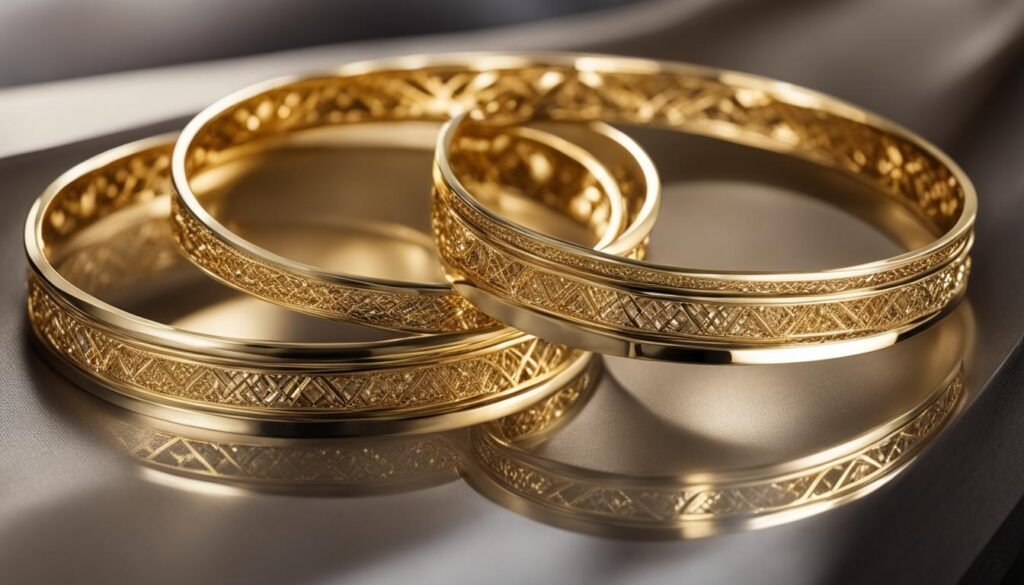
How to Tell if Your Gold-Plated Jewelry is Authentic
When purchasing gold-plated jewelry, it’s important to ensure its authenticity. Here are a few methods you can use to determine if your gold-plated jewelry is genuine:
1. Check for Hallmarks or Stamps
Genuine gold-plated jewelry often features hallmarks or stamps that indicate the purity of the gold used. Look for markings such as “GP” (gold-plated), “GEP” (gold-electroplated), or “HGP” (heavy gold plating). These markings are typically located on the clasp or inside the jewelry piece.
2. Test with a Magnet
Gold is not magnetic, so this simple test can help you determine if your jewelry is authentic. Hold a magnet near the gold-plated piece and observe if it attracts or repels. If the jewelry is magnetic, it is likely not gold-plated.
3. Examine for Discoloration or Chipping
Authentic gold-plated jewelry maintains its color and coating over time. Inspect your jewelry for any signs of discoloration or chipping. If the gold layer has faded or peels off easily, it may not be genuine gold-plating.
Remember, these methods are not foolproof, and it’s always best to consult with a professional if you have any doubts about the authenticity of your gold-plated jewelry. By taking the time to verify its genuineness, you can ensure that you’re investing in high-quality pieces.

| Signs of Authentic Gold-Plated Jewelry | Signs of Inauthentic Gold-Plated Jewelry |
|---|---|
| Presence of hallmarks or stamps | No hallmarks or stamps |
| Non-magnetic | Magnetic |
| Uniform color and coating | Discoloration or chipping |
| Verified by a professional | Doubts about genuineness |
“When it comes to gold-plated jewelry, authenticity matters. By performing simple tests and inspections, you can confidently identify genuine pieces and avoid being misled by imitations.” – Expert quote
By following these guidelines, you can make informed decisions when purchasing and verifying the authenticity of your gold-plated jewelry.
Caring for Gold-Plated Jewelry to Maintain Its Value
Proper care is essential to maintain the value of your gold-plated jewelry. By following a few simple steps, you can keep your jewelry looking beautiful and ensure its longevity.
- Avoid wearing your jewelry during certain activities: Remove your gold-plated jewelry before exercising, showering, or swimming. Exposure to sweat, water, and chemicals can accelerate the tarnishing process and cause damage.
- Store it in a safe place: When you’re not wearing your jewelry, store it in a soft pouch or cloth to prevent scratches and protect it from dust and moisture. Avoid storing it with other jewelry pieces that may scratch or damage the plating.
- Regularly clean your jewelry: Use a gentle cleaner specifically designed for gold-plated jewelry to remove dirt and oils. Avoid using any harsh chemicals or abrasive materials that can strip away the gold layer. Gently scrub your jewelry with a soft-bristled toothbrush and rinse it with lukewarm water. Dry it thoroughly with a soft cloth before storing.
- Limit exposure to lotions and perfumes: Apply lotions, perfumes, and hairspray before putting on your gold-plated jewelry. These products can contain chemicals that may react with the plating and cause discoloration.
By following these care instructions, you can enjoy your gold-plated jewelry for years to come and preserve its value. Remember to be gentle when cleaning and handling your jewelry to avoid any unnecessary wear or damage. Taking the time to care for your gold-plated pieces will ensure they continue to shine and look their best.
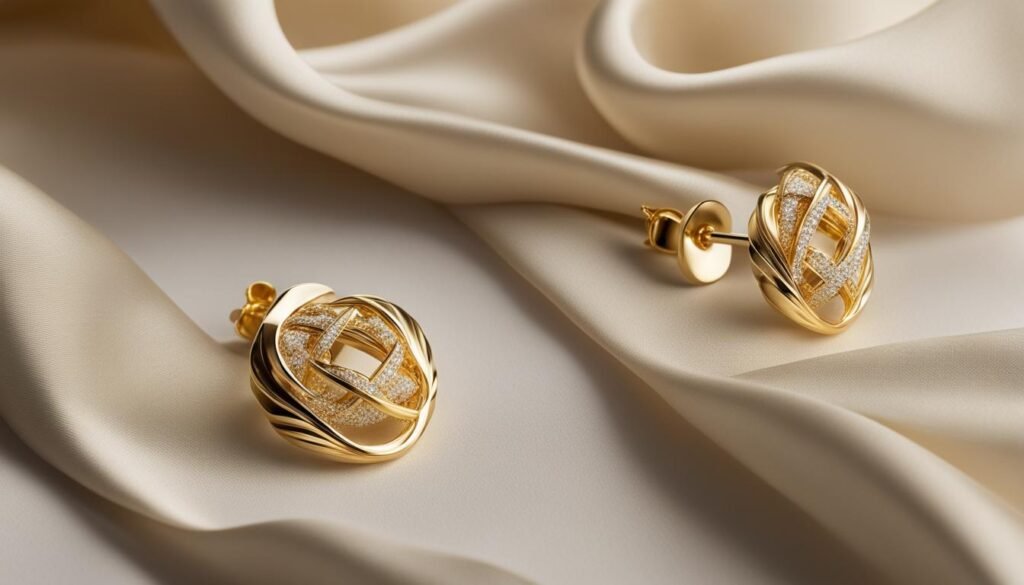
Tips for Maintaining Gold-Plated Jewelry:
- Remove your jewelry before bed to prevent damage and tangling.
- Avoid exposing your jewelry to direct sunlight for extended periods as it can cause fading.
- When cleaning, use a soft cloth or microfiber cloth to gently polish your jewelry.
- If your jewelry has gemstones, be cautious when cleaning to avoid damaging the stones.
Benefits of Wearing Gold-Plated Jewelry
Gold-plated jewelry offers a range of benefits that make it a popular choice for fashion enthusiasts. Whether you’re looking to enhance your outfit or make a style statement, here are some advantages of wearing gold-plated jewelry:
- Timeless and Classic Appeal: Gold-plated jewelry has a timeless and classic appeal that can elevate any outfit. Whether you’re attending a formal event or simply dressing up for a casual outing, gold-plated jewelry adds an elegant touch to your overall look.
- Hypoallergenic: If you have sensitive skin or metal allergies, gold-plated jewelry is an excellent option. It is hypoallergenic, meaning it is less likely to cause irritation or allergic reactions compared to other metals.
- Durable and Resistant to Tarnishing: Gold plating is known for its durability and resistance to tarnishing. With proper care, gold-plated jewelry can maintain its shine and luster for a long time, allowing you to enjoy its beauty without worrying about discoloration or fading.
When accessorizing with gold-plated jewelry, you can choose from a wide range of designs, including earrings, necklaces, bracelets, and rings. Whether you prefer a delicate and understated piece or a bold statement accessory, gold-plated jewelry offers versatility and options to suit your personal style.
“Gold-plated jewelry adds a touch of sophistication to any outfit, making you feel confident and stylish.” – Fashion Expert
Table: Comparing Gold-Plated Jewelry with Other Materials
| Material | Advantages | Disadvantages |
|---|---|---|
| Gold-Plated Jewelry | Timeless appeal Hypoallergenic Durable and resistant to tarnishing | May require re-plating over time |
| Solid Gold Jewelry | Intrinsic value Long-lasting Does not tarnish | Expensive May require professional cleaning |
| Silver Jewelry | Versatile Less expensive than gold Does not tarnish easily | Requires regular cleaning May cause allergies in some individuals |
As shown in the table, gold-plated jewelry offers a balance between affordability, aesthetics, and durability. It allows you to enjoy the beauty and elegance of gold without the high cost associated with solid gold jewelry.

With its timeless appeal, hypoallergenic properties, and resistance to tarnishing, gold-plated jewelry continues to be a popular choice for those looking to enhance their style and make a fashion statement.
Where to Buy Quality Gold-Plated Jewelry
If you’re looking to buy quality gold-plated jewelry at a reasonable price, there are several options available both online and offline. Local jewelry makers often offer unique pieces that are handmade with attention to detail. These local artisans can provide personalized service and may even be open to customizing jewelry to suit your preferences.
Another great option is to explore online shops that specialize in gold-plated jewelry. Online platforms often offer a wider range of designs and styles, allowing you to find the perfect piece to match your taste. Additionally, online shopping provides the convenience of browsing and purchasing from the comfort of your own home.
When searching for a reputable source, it’s important to do your research. Look for reviews and ratings to ensure that the seller has a good reputation for selling high-quality gold-plated jewelry. Reading customer feedback can give you valuable insights into the quality and durability of the products they offer.
It’s also worth keeping an eye out for sales and discounts at larger retailers. These retailers often stock a variety of gold-plated jewelry options at competitive prices. However, be cautious of deals that seem too good to be true, as they may indicate low-quality or counterfeit products.
| Pros | Cons |
|---|---|
|
|
By choosing a reliable source to buy your gold-plated jewelry, you can ensure that you’re getting a high-quality product that will retain its beauty and shine for years to come. Whether you decide to explore local options or shop online, take the time to find a trusted seller who offers authentic gold-plated jewelry at a reasonable price.
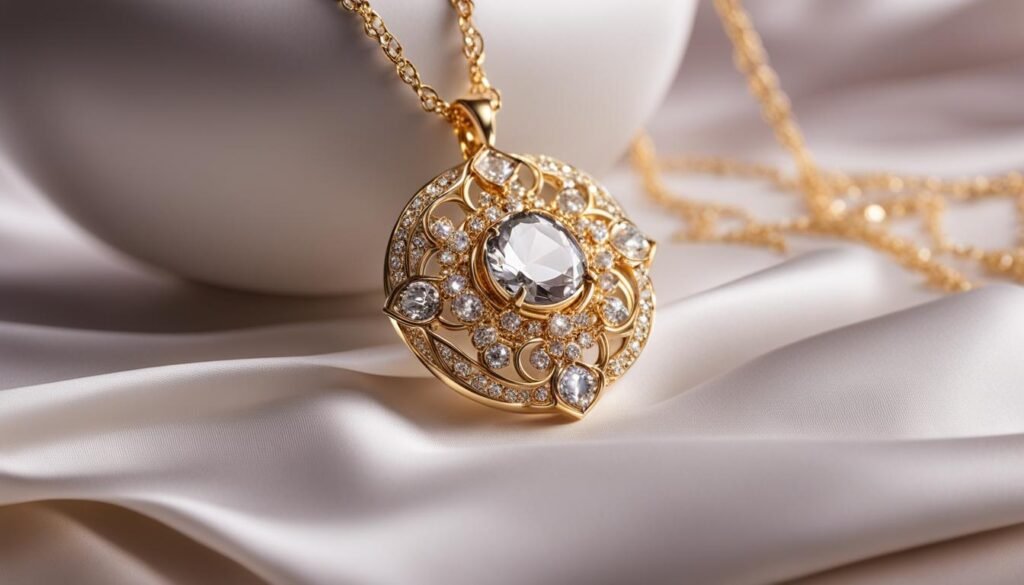
How Long Can Gold Plating Last?
Gold plating has a lifespan that can vary depending on various factors. The care, usage, and thickness of the gold plating all play a role in determining how long it will last. Generally, with proper care, gold plating can last a few years before showing signs of wear. However, it’s important to note that the thin layer of gold used in plating can wear off over time.
One way to extend the lifespan of gold plating is to apply a clearcoat or protective coating. This additional layer can provide extra protection against tarnishing and wear. It’s essential to choose a coating that is specifically designed for gold-plated jewelry to ensure compatibility and maximum effectiveness.
When it comes to caring for your gold-plated jewelry, proper maintenance is key. Avoid exposing it to harsh chemicals, such as cleaning agents, as they can strip away the gold layer. Instead, clean the jewelry gently using a mild dish detergent and water mixture. Be sure to dry it thoroughly and store it in a separate pouch or cloth to prevent scratches.
By following these care instructions and considering additional protective measures, you can help prolong the lifespan of your gold-plated jewelry and enjoy its beauty for years to come.
The Risks and Considerations of Home Gold Plating Kits
If you’re considering using a home gold plating kit, it’s important to be aware of the risks and considerations involved. While these kits may seem like a convenient and cost-effective solution, there are several factors to keep in mind before diving into the world of DIY gold plating.
One of the main risks of using a home gold plating kit is the potential for mistakes. Plating gold requires precision and expertise, and without proper knowledge and training, you may not achieve the desired results. Gold is an expensive metal, and any errors can be financially costly.
Another consideration is the investment required for a home gold plating kit. These kits can be quite expensive, and you’ll need to weigh the cost against the benefits and potential risks. It’s important to consider whether you have the necessary budget and commitment to pursue gold plating at home.
“Plating gold requires precision and expertise, and without proper knowledge and training, you may not achieve the desired results.”
Before attempting gold plating at home, it’s recommended to seek professional advice or consider working with a reputable gold plating company. They have the knowledge and experience to ensure accurate and reliable results. Additionally, they can provide guidance on the appropriate techniques and materials to use for your specific project.
By carefully weighing the risks and considerations of home gold plating kits, you can make an informed decision about whether this is the right path for you. Remember, it’s essential to have the necessary skills, knowledge, and resources to achieve the best possible results when it comes to gold plating.
| Risks | Considerations |
|---|---|
| 1. Potential for mistakes | 1. Investment required |
| 2. Financial cost of errors | 2. Professional advice |
| 3. Lack of precision and expertise | 3. Reputable gold plating company |
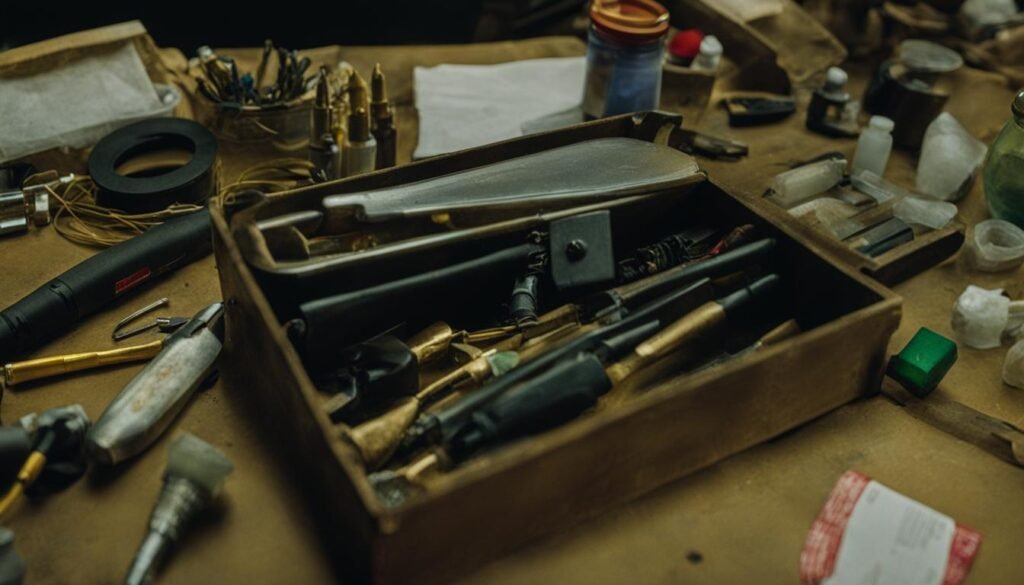
Summary:
In summary, using a home gold plating kit involves certain risks and considerations. Mistakes can be costly, and proper knowledge and training are essential for achieving satisfactory results. Additionally, the investment required for a home kit should be carefully weighed against the benefits. Seeking professional advice or working with a reputable gold plating company is recommended to ensure accurate and reliable plating. Consider the risks and considerations before deciding to pursue gold plating at home.
Conclusion
In conclusion, gold-plated jewelry is a popular choice for its affordability and attractive appearance. However, it can tarnish and turn green over time due to factors such as chemicals, moisture, and improper care. To prevent this issue, it is important to take preventive measures and follow proper care instructions.
By avoiding the use of chemicals and cleaning your gold-plated jewelry with a gentle cleaner, you can help maintain its shine. Be sure to dry the jewelry thoroughly after cleaning and store it separately to prevent scratching. It is also crucial to understand the difference between gold and gold-plated jewelry and how to determine if the jewelry is authentic.
Choosing quality gold-plated jewelry and practicing proper care techniques can help you enjoy the elegance and shine of gold without the high cost. Remember, taking care of your gold-plated jewelry is essential to preserve its appearance and value for years to come.
FAQ about Does Gold Plated Jewelry Turn Green
Does gold-plated jewelry turn green?
Yes, gold-plated jewelry can turn green over time due to factors like chemicals, moisture, and improper care.
How does gold plating work?
Gold plating is the process of covering a base metal with a thin layer of gold, giving the item the appearance of solid gold.
Why does gold-plated jewelry tarnish?
Gold-plated jewelry can tarnish due to various factors, including chemicals, oils and moisture from our bodies, and improper storage.
How to prevent gold-plated jewelry from turning green?
To prevent gold-plated jewelry from turning green, avoid using chemicals on it, clean it with a mixture of water and mild dish detergent, and store it properly.
What is the difference between gold and gold-plated jewelry?
Gold-plated jewelry is a base metal covered with a thin layer of gold, while real gold is made up of a solid alloy mixed with other metals.
How to tell if your gold-plated jewelry is authentic?
Check for hallmarks or stamps indicating real gold, use a magnet (as gold is not magnetic), and look for signs of discoloration or chipping.
How to care for gold-plated jewelry to maintain its value?
Avoid wearing it during activities that can cause damage, clean it regularly with a gentle cleaner, and store it in a safe place to prevent scratches.
What are the benefits of wearing gold-plated jewelry?
Gold-plated jewelry has a timeless and classic appeal, is hypoallergenic, and is durable and resistant to tarnishing.
Where can you buy quality gold-plated jewelry?
You can find quality gold-plated jewelry at local jewelry makers, online shops, and larger retailers during sales and discounts.
How long can gold plating last?
The lifespan of gold plating can vary but generally lasts a few years with proper care.
What are the risks and considerations of home gold plating kits?
Home gold plating kits can be expensive, require proper knowledge and training, and mistakes can be costly. Consider working with a reputable gold plating company or seeking professional advice.
Source Links
- https://medium.com/@namasyajpr/is-gold-plated-jewelry-worth-anything-39c6f4a186b3
- https://bentleyandlo.com/blogs/news/how-to-care-for-gold-or-silver-plated-jewelry
- https://www.finishing.com/415/17p5.shtml

